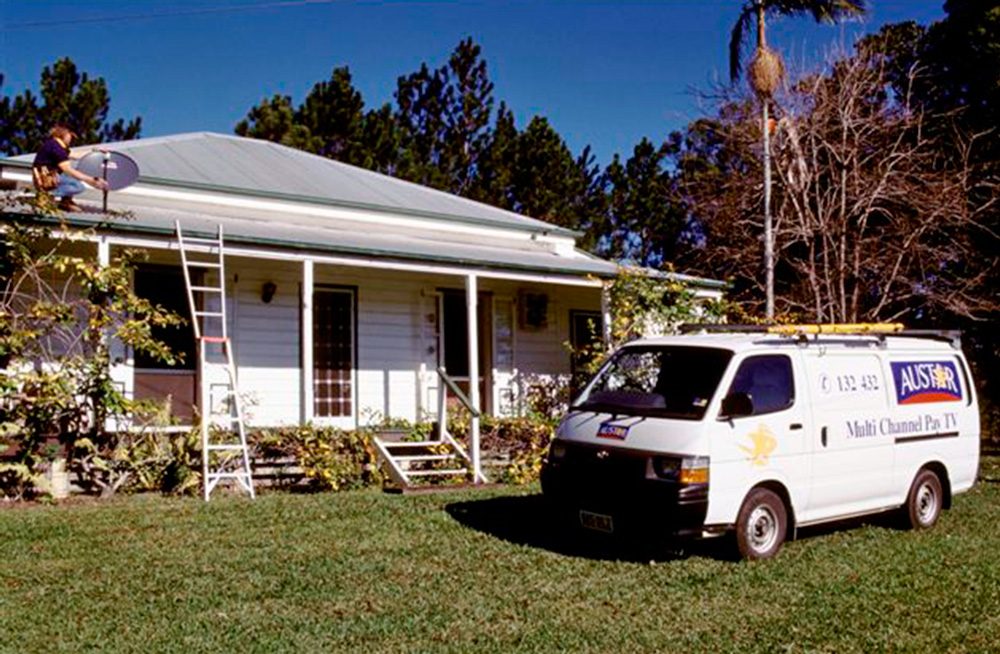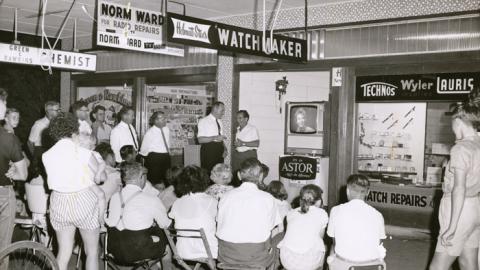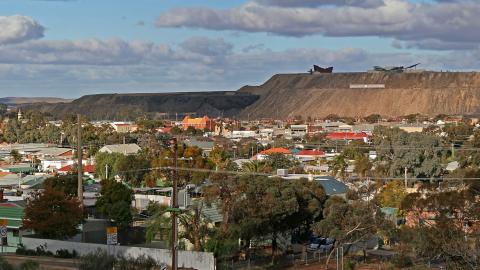

Regional TV: Colour to Digital
Regional TV: Colour to Digital
Bronwyn Barnett draws on the NFSA collection to tell the story of regional television from the late 1960s to the present. See also Regional TV in Australia.
Growth and innovation
As the 1960s drew to a close and the 1970s began, more regional stations opened across the country. The installation of translator stations across a wider area gave more rural viewers access to television. Some of the later stations to open in South Australia, Western Australia and the Northern Territory serviced vast areas with small populations, which brought in less revenue than the more highly populated regions. The high cost of broadcast equipment made operating these stations a constant challenge, but with low budgets comes innovation.
In keeping with the need for rural television stations to reflect their communities’ way of life, they broadcast locally produced news, current affairs, variety and talk shows, and local sport. The pick of the best shows from the metropolitan stations and overseas rounded out the programming schedule.
One of the setbacks to news services was the inability to broadcast national and international news film on the same day a story broke. The news, recorded on 16mm film, had to be copied then freighted to individual stations from capital cities which, depending on the rural destination, could take up to several days.
The advent of microwave links in the late 1960s, and later satellites, revolutionised what the stations could offer their viewers:
Michael Devine, presenter of the CBN 8 Orange program Ten Years of Progress, explains how microwave links and satellites brought the world to CBN 8 and CWN 6 viewers. Courtesy: Prime7. NFSA: 441919
C-day
The next development in Australian television was compared by Australian Broadcasting Control Board Chairman Myles Wright as being ‘…just like the introduction of talkies all over again’ (The Sun newspaper, 29 July 1972). Although introduced in the USA in 1953, it was not until 15 February 1972 that the Australian government announced that colour transmission (at the time referred to as ‘color’) would commence on 1 March 1975 (C-day). Unlike the phased introduction of regional television, colour transmission would arrive on the same day in both metropolitan and regional areas. Bruce Gyngell, then Managing Director of Channel 7, wasn’t sure that all television stations could convert at the same time and believed that there should be a phasing-in, with Sydney and Melbourne being the first to broadcast colour in Australia, followed by the other major capital cities, then the provincial stations.
In July 1972 Wright met with 28 country station managers in Bendigo to determine their ability to broadcast in colour from 1 March 1975. The managers agreed they could meet the deadline and decided to purchase the necessary equipment in bulk to cut costs. Arthur Evans (Managing Director, TNT 9), who chaired the meeting, stated that, ‘If we bought these things individually we’d only have to look at the costs and we’d all go broke’ (The Sun, 29 July 1972). Some other regional stations were not able to transmit in colour from C-day, for example South Western Telecasters Ltd (WA) announced in their 1973 annual report that funds would be made available to complete conversion but colour transmission would not commence on 1 March 1975.
In order to convert to colour, regional stations had to expand their studios to accommodate the new equipment. CTC 7, Canberra, was the only station to completely rebuild for colour. Chairperson Arthur Shakespeare announced that the company would spend about $2 million on conversion, which included the building of new studios. With stations only allowed to broadcast test colour transmission from October 1974 to C-day, these new studios landed CTC 7 in a bit of trouble with the Australian Broadcasting Control Board:
CTC 7 Canberra General Manager George Barlin discusses in 1990 how the station began broadcasting in colour 6 months prior to the official commencement of colour television transmission. NFSA: 224309
Satellites converging
Having successfully transitioned to colour, the regional television landscape went through a period of relative stability and healthy revenue. Technology was creating new opportunities and regional stations were looking at the potential changes to traditional operations that these advances could bring.
Chief amongst them was satellite, as Ian Ridley – General Manager of Country Television Services – explains in an interview with Roger Dunne for their network’s 21st birthday special, 21 Years of Local Production (1983):
Ian Ridley, General Manager of Country Television Services, talks about new technologies being faced by country television stations. Courtesy: Prime7. NFSA: 441923
Satellite of course presented an opportunity not only to improve local service to communities but also to bring television to remote areas that, until the mid-1980s, had no access to the medium. Jack Gleeson, Managing Director of NQTV (Northern Queensland), explains how he sought support to provide a remote-areas service in Queensland and northern New South Wales, which launched in April 1988 as QSTV:
Jack Gleeson, Managing Director of NQTV, talks about a commercial satellite service covering remote areas of Queensland and NSW. Courtesy: Jack Gleeson. NFSA: 1056817
The introduction of the Aurora and VAST satellite services expanded television coverage to remote areas in Victoria, Central and Western Australia. Jack Gleeson became one of the Foundation Directors of the federal government’s domestic satellite service AUSSAT. As Nick Herd states in Networking: Commercial Television in Australia (2012, Currency House, p 177):
'It is worth noting that the arrival of the domestic satellite arguably represents the start of a process of convergence between television and telecommunications which is still continuing. An alternative mode of delivery for the first time had created the possibility of a new business model for the industry.'
While technology gave operators more freedom to improve their services to viewers, it also brought a risk to the localism of regional television, as the GMV 6 (Shepparton/Goulburn Valley) public affairs program Outlook (1985) explains:
Localism is the reason for existence of regional broadcasters and the point of difference from capital city services. Courtesy: WIN Television. NFSA: 63920
Regional equalisation
The biggest challenge to regional television maintaining localism as its point of difference came in the late 1980s with the introduction of aggregation. George Barlin, former General Manager of CTC 7 Canberra, explains the concept and an alternative proposal that was put forward for bringing equalisation to regional areas: supplementary licences:
Interviewed in 1990, former Managing Director of CTC 7 Canberra, George Barlin, gives his opinion about the origin of aggregation and the problems he foresaw with it. NFSA: 224309
Where regional stations previously used to pick the best of the metropolitan programs to broadcast, aggregation made it necessary for them to affiliate with a network – either 7, 9 or 10 – for the supply of programming. This ensured that the networks were each represented in regional markets by the three aggregated television operators (WIN, Prime and Southern Cross). This move to network affiliation created problems for the proprietors of Telecasters North Queensland:
Jack Gleeson, Managing Director NQTV (Northern Queensland), talks to interviewer Danny O’Neill in 2012 about rejecting affiliation with the Nine Network for Network Ten. Courtesy: Jack Gleeson. NFSA: 1056817
Regional operators saw the threat to localism if they aggregated and objected to the proposal. Until that time, regional television was enjoying a prosperous period in which profits were reinvested into the stations in the form of local productions, generating local employment. A case in point was CTC 7, then owned by Kerry Stokes:
Former Managing Director of CTC 7 Canberra, George Barlin, talks in 2002 about Kerry Stokes and his investment in local production. Courtesy: Southern Cross Austereo. NFSA: 570569
The federal government’s objective of regional equalisation brought aggregation to regional television. The first markets to aggregate were Southern NSW and the ACT on 31 March 1989, followed by regional Queensland (31 December 1990). Northern NSW markets aggregated on 31 December 1991, followed by regional Victoria on 1 January 1992:
Aggregation comes to regional Victoria. Courtesy: WIN Television. NFSA: 65516
Tasmania aggregated on 30 April 1994 with the Launceston-based station affiliating with both 7 and 10, as the Hobart-based station affiliated with 9. Aggregation was not initially implemented in Western Australia, South Australia or the Northern Territory because of the coverage area being too widespread or the population being insufficient to support three commercial stations. Some markets received supplementary licences.
Stations moving into aggregated markets faced the challenge of breaking through the loyalty of viewers in the new regions who remained steadfast in their support of the original broadcaster:
Kate Quinn, Programs, Publicity & Promotions Manager with Canberra’s Capital Television, talks in 2012 about issues faced when aggregating into the Central West of NSW. NFSA: 1071637
Although more densely populated, the east coast regions still had relatively small markets, and were facing a downturn as the economy moved into recession. The federal government gave licence-fee rebates to assist with the outcomes of aggregation but the costs associated with it (building new stations and transmission towers into neighbouring areas) and the competition for the advertising dollar (now split between three television operators) forced some tough business decisions on the regional television operators:
Engineer Peter Smart talks in 2008 about the effects of aggregation on local production. Courtesy: FOXTEL Management Pty Ltd. NFSA: 786350
Gradually, as predicted by the regional operators, the stations reduced their production of local programs in favour of networked programming from their affiliated metropolitan operators. This led to the loss of identity of what once were local stations, and meant:
'… everything which was done in the past to ensure that stations were local and not under the control of metropolitan interests is to be undone and those things for which we fought so strongly against Packer and Henderson a quarter of a century ago now mean nothing' - GK Barlin, 25 Years of an Almost Impossible Dream (1987, Chapter 17)
Also at this time, the small regional networks formed in the late 1970s and early 1980s began to buy stations in aggregated markets to form larger regional networks, each affiliated with a metropolitan network. Regional networks WIN (9), Prime (7) and Southern Cross Broadcasting (10) began to brand themselves in each market and also took the on-air branding of their affiliated network, furthering the loss of local identity. NBN was the exception, with the station affiliating with 9 but remaining independent.
Whilst aggregation was designed to benefit viewers in regional areas, in 2001 the Australian Broadcasting Authority began an investigation into the provision of local programming by aggregated operators. The review of regional television news and information services stemmed from viewer outrage over the cancelling of local news services by Prime and Southern Cross. The reason given by Southern Cross Broadcasting at the time was that it wasn’t economically feasible to continue broadcasting local programs at the same level as in the past. The outcome of the review was that aggregated regional operators would have to provide a minimum level of local news and information in each market which would be measured by a quota system.
Aggregation is now part of everyday operations and the regional networks have settled into continued provision of local programs, albeit not on the same level as pre-aggregation.
Paying for television

The next perceived threat facing free-to-air television – both metropolitan and regional – was subscription television. On 26 January 1995, Galaxy became the first subscription television provider to begin operations.
AUSTAR was founded in 1994 as Community Entertainment Television (CETV) and became the largest subscription television operator in rural and regional Australia, primarily using satellite technology and operating a cable network in Darwin.
The FOXTEL takeover of AUSTAR was completed on 24 May 2012, bringing greater viewing opportunities to regional viewers.
Farewell to analogue
Hot on the heels of subscription television was the next big industry shake-up. In March 1998 the introduction of digital television was announced. Australia would commence digital terrestrial television in 2001, with broadcasters allowed to simulcast analogue and digital until 2008.
Regional networks prepared for digital television with the assistance of licence rebates. Digital technology enabled them to cut costs in certain areas with leaner operations. As Jack Gleeson explains:
Jack Gleeson, former Managing Director of NQTV (Northern Queensland), talks in 2012 about networking into eight different markets from Townsville. NFSA: 1056817
Of course what Mr Gleeson is referring to is just the tip of the iceberg in today’s television landscape. Digital technology has enabled regional networks to broadcast content and local commercials, plus their affiliated network’s multiple channels, into hundreds of markets from playout centres in central broadcast locations.
Although subscription television operator FOXTEL switched off its analogue signal in 2007, regional television paved the way for free-to-air television’s move to digital. On 30 June 2010, Mildura, Victoria became the first free-to-air television market to switch off its analogue signal:
Digital television comes to Mildura: WIN News, 30 June 2010. Courtesy: WIN Television. NFSA: 809389
Other challenges
Other challenges facing television operators into the future include converging media, which was examined by the Convergence Review (established by the federal government in 2010). When the first regional licences were applied for, it was by companies that included radio and newspaper proprietors. Although operating in the same markets, the three mediums were independent of each other. Now radio and television networks are merging and newspapers are forming partnerships with broadcasters for their online content.
Television viewers are no longer reliant on a box in the corner to passively entertain them, nor are regional viewers waiting days to see what is happening outside their local regions. News and entertainment from any part of the world is at their fingertips any time of the day or night – and it’s portable. The broadcast industry is developing ways of using the internet to enhance the viewing experience. Internet Protocol Television (IPTV) is to viewers in the early 2010s what colour TV was in the 1970s.
With more economic hardship predicted as advertising revenue splits from traditional media to the internet, television operators are again facing financial challenges. But as we’ve seen, the regional television industry is adaptable and regional TV retains an important place in the communities of regional viewers:
Mildura: 50 Years of Regional Television, 2010. Courtesy: WIN Television. NFSA: 809389
References
Herd, Nick (2012) Networking: Commercial Television in Australia, Currency House, Strawberry Hills
Barlin, GK (c1987) 25 Years of an Almost Impossible Dream, The Queanbeyan Age
Flynn, John Michael (2008) Locally Significant Content on Regional Television: A Case Study of North Queensland Commercial Television Before and After Aggregation, Thesis submitted to the Creative Industries Faculty, Queensland University of Technology for the degree of Master of Arts (Research).
This article was first published in 2012 and updated in 2022.
The National Film and Sound Archive of Australia acknowledges Australia’s Aboriginal and Torres Strait Islander peoples as the Traditional Custodians of the land on which we work and live and gives respect to their Elders both past and present.


